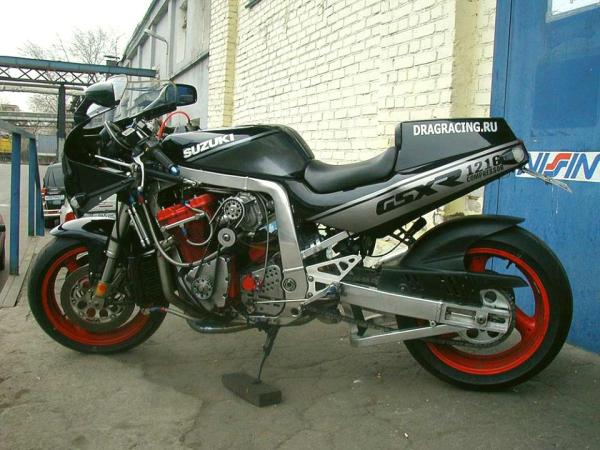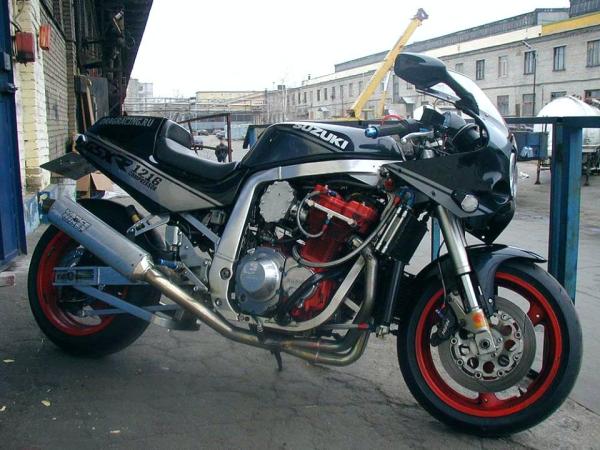-
Posts
5,758 -
Joined
-
Last visited
Content Type
Profiles
Forums
Events
Everything posted by Gixer1460
-
Lots of Funny and ProMod bikes making more than 500hp and still using 1150 cases, 1100 cases and in some instances Zed cases!
-
Seen plenty of cracked heads GSX and GSXR used on the street and in racing and not one ever had a seat move or cause a problem other than looking ugly!
-
Depends on what 1100? Slabside or Slingshot ? What you quote (although in antiquated measurements LOL) is correct for 89 on GSXR1100 K, L, M and N. If its the earlier engine, then the measurement is 4.261" / 108.23mm
-
60 ! - a mere whippersnapper !
-
Applies in both cases and if you want to loose compression - for a turbo using hi comp pistons that are forged (because that is what you've got!)
-
This one flew under the radar when it was posted but just grabbed my attention - if they are the same weight but physically the same size that would imply they are of a slightly lighter steel? I see that the GSXR rod has a 'chunkier' big end with longer bolts but Busa shank and small end are somewhat larger in comparison. As regards strength - unprepped GSXR rods almost guaranteed to fail at 250hp with NOS and under 300hp with turbo. If prepped then maybe 5-10hp more but risky - I don't believe aftermarket rod bolts are available which would help. Not seen too many Busa rod failures so can't say about their strength but they 'look' as if they've got metal in the right places - rod bolt looks weak though!
-
Swapping shim valve actuation to 'normal' rocker arm actuation . . . . . . . pointless IMO in a turbo engine that is unlikely to be over revved!
-

Stick Coil Conversion
Gixer1460 replied to TJS's topic in Water Cooled, V-Twins, Singles and 2-strokes
I'm no electrickery expert but I think if the sticks are paralleled like opt 2 you'll get 12v but circuit resistance is halved so twice the amps will flow - so stressing the ignition amp transistors. 12v @ 3 ohms = 4A, 12v @ 1.5 ohms = 8A. But parallel gives 12v @ 0.75 ohms = 16A! Please get an adult to check the above. -
Interestingly, your quoted part number - not found ! Kent only list two cams for the GSX11 - SUZ 5 (street) and SUZ 17 (race)!
-
You may be an old man but you are likely to get some flak for that post!
-
I'm with Arttu on this one - I can't see the second gear being a problem (I'd never heard about that problem !) particularly as this is happening in 1st gear ! And as said, its not occuring where usual slip occurs. So, I believe this is more of an engagement issue, like, although the lever is fully thrown and clutch should be 'locked' somewhere between the handlebar and the clutch pack there is a hang up stopping full engagement - something like bad adjustment / cable too tight or what I suspect - a frayed cable inner somewhere? I'd try a different cable, if only to elliminate that?
-
More than likely - you ain't going to be spoiled for choice in those sizes these days!
-
Good call - I only looked as far as the EFE's LOL! Bandit part numbers different (probably due to their bolts not being drilled for a split pin) but lengths appear to match! Don't mention measurement ! ! !
-
Do you want someone to fit them as well? Surely you can measure the width of the bracket and add 10mm for a nut and washer? BTW my recommendation above was ASSUMING a M8 bolt - it maybe M10 as I assumed you be aware!
-
As they are discontinued, a used old stock supply may be located after a couple of years (or not!) You could try a regular bolt supplier - https://www.accu.co.uk/84-socket-shoulder-screws?Material=Stainless+Steel+(A2)&Shoulder+Length+(L)=25mm%2C30mm%2C35mm&Thread+Size+(T)=M8+(8mm)&page=1 or maybe consider a HT regular bolt with an added sleeve to replicate the shouldered regular bolt. As the arm is designed to pivot on the shoulder (and wear a groove into it, as I remember!) if the sleeve span as well = less wear and easier to replace ?
-
He's not far wrong LOL. From the manual 3.25H 19 4PR and 4.00H 18 4PR. And scribbled beside (as those harder to find in '85) 100/90 H19 & 120/90 H18, so nearly right !
-
I'm not near my Workshop manual but 100/80 x 19 fronts and 130/70 x 18 (or 19) sounds familiar.
-

Does anyone know how much hose I need for an oil cooler setup?
Gixer1460 replied to gorbys's topic in Air Cooled
-8 hose ok, imo -10 is better, I wouldn't even use -6 for a head cooler! -

Does anyone know how much hose I need for an oil cooler setup?
Gixer1460 replied to gorbys's topic in Air Cooled
Two metres 'may' do it but you'll kick yourself if you are short! -
So how do you explain a Dual Pod equipped GSXR1100 working fine with just the addition of a DJ kit ? Yes, a DJ kit modifies the way the slide responds but doesn't require intake 'modification' of airflow. Just turn the rubbers upside down then you aren't wedging the foam against the frame ? And forgive me for noticing but the carbs in the pictures above are slide types so will virtually function quite well without any sort of induction modification IMO.
-
Can't complain about the 200g LOSS in weight but as regards access - Hmmm! If you put the replacements where the factory wants you to put them, then yes I agree - so put them somewhere else! I had mine under the seat with my turbo install - lift seat instant access, just long plug leads. Getting sticks out from a tight under tank is still a PITA.
-
Basically whatever you use / find, each individual coil should be no less than about 1.2 ohms and even this is pretty close to the edge for std 30 yr old ICU's which are used to working with 3.0 ohm circuit and 2x 1.2 ohm sticks = 2.4 ohm. The lower the ohms with a 'fixed' voltage, the higher Amps will flow - this is what stresses the ICU's power transistors, so a stick with 1.5 ohm resistance would be ideal. Other useful tip is - if possible - change the spark plugs from 'old style chunky tip' types to the 'thin tip' iridium / platinium type which tend to spark easier with these coils at lower voltages (sticks in series are only working with about 6.5 - 7v! each)
-
I am guessing that Audi and other OEM's aren't looking for extreme performance gains via the A/W IC's but just to 'take the edge off'. If the turbo is boosting to a couple of bar and its air temps are say 150 deg C then engine water temps of around 90 deg C offers a potential sink for the compressed air temps. Getting compressed air down to ambient is a great goal but most A/A IC's are barely 30-40% efficient so struggle to get a similar high temp down obviously subject to size constraints. My thinking is oil to water oil coolers have been mainstream for a long time so similar performance could be available in air - water IC's?
-
Great devices for older bikes / cars - absolute PITA for a multi cylinder bike or anything with deep plug holes as you just can't see Jack! Can you imagine trying to do a CBX ! ! !




